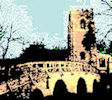Medbourne - Snippets from the Past
As we gather historical information about the Village various items turn up that are interesting. Some make complete stories; for others further research yields little extra information and we are left with an interesting "snippet". Some of these are quite colourful and well worth the read.
This page is devoted to these mini stories from the past. Click a link below to reach an item directly:
- The Battle of Medbourne?
- What not to do on Guy Fawkes night
- Poachers attack a Baronet
- Fox Hunting - potted history
The Battle of Medbourne?
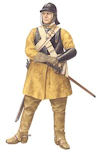 ... more a serious fatal skirmish in 1646
... more a serious fatal skirmish in 1646
Medbourne suffered badly at the end of the English Civil War. On 3rd April 1646 ten parliamentarian troopers entered the village bent on plunder. The villagers resisted and fought the looters off. The parson arrested one and locked him in the church. The building was easily defended because the local stream acted as a moat. The looters retreated and returned with twenty cavalrymen. The locals were no match for the professionals; many were killed, not least of all the parson’s servant, who “had his bowels let out with wound”. The Parliamentarians sacked the village, driving off all the village cattle.
Published with the kind permission of Trevor Hickman from his book "Market Harborough And The Local Villages".
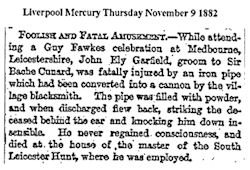 What not to do on Guy Fawkes night
What not to do on Guy Fawkes night
News clipping from the Liverpool Mercury, November 9th 1882.
While attending a Guy Fawkes celebration at Medbourne, Leicestershire, John Ely Garfield, groom to Sir Bache Cunard, was fatally injured by an iron pipe which had been converted into a cannon by the village blacksmith. The pipe was filled with powder and when discharged flew back striking the deceased behind the ear and knocking him down insensible. He never regained consciousness and died at the house of the master of the South Leicestershire Hunt where he was employed.
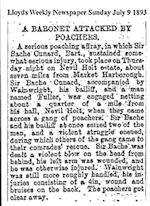 Poachers attack a Baronet
Poachers attack a Baronet
News clipping from Lloyd's Weekly Newspaper, July 9th 1893.
A serious poaching affray in which Sir Bache Cunard, (Baronet) sustained somewhat serious injury, took place on Thursday night on Nevill Holt Estate about seven miles from Market Harborough. Sir Bache Cunard accompanied by Wainwright his bailiff and a man named Fuller was engaged netting about a quarter of a mile from his hall, Nevill Holt, when they came across a gang of poachers. Sir Bache and his bailiff at once seized two of the men and a violent struggle ensued, during which others of the gang came to their comrades rescue. Sir Bache was dealt a violent blow on the head from behind, his left arm was wounded and he was otherwise injured. Wainwright was still more roughly handled, his injuries consisting of a 4in. wound and bruises on the back. The poachers got clear away.
Fox Hunting - potted history
When Sir Bache Cunard retired in 1888 he was succeeded by Charles Fernie of Keythorpe Hall who was to remain Master for 31 seasons (although he himself hunted infrequently after a bad hunting accident in 1906). In that period he employed two celebrated huntsmen. The first was Charles Issac, huntsman until 1901 and also creator of some well known coverts in the country – an excellent horseman. He was succeeded by Arthur Thatcher, generally reckoned to be one of the three great huntsmen of the “golden era” (Firr of the Quorn, Thatcher of the Fernie and Freeman of the Pytchley). The sport shown in that period, when the country was all grass and there was virtually no wire (at least during the winter) was of a very high order. At that time Harborough overtook Melton as the centre of the fox hunting world. A Monday or a Thursday with the Fernie was certainly a much sought after day in the hunting calendar. The presence in Great Bowden of John Henry Stokes, the principal horse dealer in Europe also contributed significantly to the popularity and standing of the hunt.
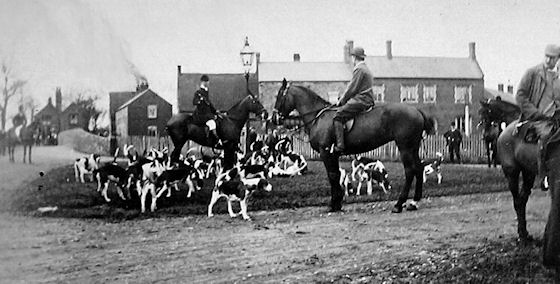
Mr. Fernie's hounds gather with the Nevill Arms in the background.
Many of the famous hunts took place at this time, including the celebrated Hegg Spinney run from near Hallaton in 1911, much of which took place over the present Cottesmore country, ending near Oakham after a hunt of three hours twenty minutes and twenty eight and a half miles with a nine mile point – a hunt to compare with the Waterloo and Greatwood runs elsewhere.
After Mr Fernie’s death in 1919 his widow continued as Master for a couple of seasons and then retired, giving the hounds to the country, which has continued to bear his name ever since. Lord Stalbridge came from Wiltshire as Master and built new kennels at Great Bowden (Mr Fernie had been in Medbourne since 1878). Many of the Masters between the Wars were very rich men, these included the South African diamond magnate Sir Harold Werner and the Scottish land owner Charles Edmonstone. The latter planted two of the principal coverts on the west side of the country and named them after his American wife and himself, Gwens and Charlies. Bert Peaker was an excellent huntsman for much of this time and kept the hunt going during the Second World War. In austerity years following the War much of the country was ploughed up and hunting undoubtedly became more difficult.
Acknowledgements
Article compiled by Keith Sandars with thanks to Mick Cooper and Trevor Hickman. November 2016.
